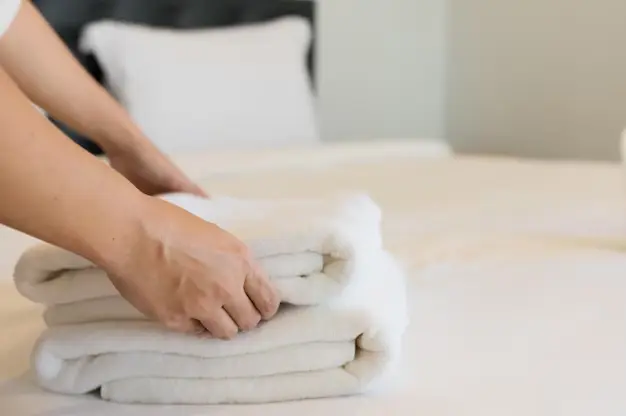Duvet covers provide purposes beyond simple protection of your comforter. They directly affect how comfy and clean your sleep experience is and help to define the look and feel of your bedding. Like anything else, though, their softness and quality will deteriorate with neglect. Knowing how to treat your duvet covers depending on their particular bed sheet material will help you to keep them in perfect shape. Your cleaning practices count if your preference is for soft bamboo or pure cotton. Using actual advice everyone can follow, this article will walk you through every process required to keep your duvet covers nice and lifetime intact. Your gorgeous bedding will remain lovely and inviting for years with just a little work.
Step 1: Know Your Bed Sheet Material
Underwater, heat, and detergent, every bed sheet material acts differently. For instance, cotton shrinks when laundered hot, even if it is robust and breathable. Though bamboo is environmentally friendly and delicate, strong detergents can cause it to fade. Though it needs extra delicate treatment, eucalyptus (Tencel) is velvety and cool. Protecting your duvet cover starts with knowing exactly what it is comprised of.
A 2023 worldwide textile report revealed that cotton is still the most often used material in duvet covers, accounting for 40% of all bedding products. Reading the label before you throw something into the washer makes sense. One little error—such as washing bamboo on high heat—can affect the lifetime feel of your preferred bedding.
Step 2: Wash Gently, Not Just Often
Unless something spills on your duvet cover, you should not wash it every week. Most homes find sufficient washing every two to three weeks. When you do, though, be careful. Use cold water always, unless the care tag advises otherwise. Particularly if the bed sheet material is naturally coloured, hot water might cause fading and leave your duvet cover coarse.
Try a moderate detergent free of fabric softeners or bleach. Though softeners may sound like a wonderful idea, they leave a layer over the cloth that truly makes it feel stiff over time. Instead, toss a cup of white vinegar during the rinse cycle to help maintain the fibers smooth and silky.
Step 3: Avoid High Heat When Drying
Drying is the process that causes most damage. High dryer heat can destroy the texture and shorten the lifetime of your duvet cover, whether it is composed of bamboo, cotton, or eucalyptus. When practical, especially in sunny and dry conditions, choose air drying. It preserves the structure of the bed sheet material in addition to saving energy.
If you use a dryer, choose a low-heat setting and remove the duvet cover as soon as it becomes dry. Ignoring it too long could cause creases and possibly overdrying of the threads. Gently shake the duvet cover before folding to maintain that clean, hotel-style appearance that so many people enjoy in luxurious bedding.
Step 4: Store It Right to Keep It Fresh
Just as vital as washing your duvet cover is storing it correctly. Once dry and clean, do not pack it into a plastic bag or drawer. Store it in a light cotton bag or linen sack. This keeps the fabric dust and humidity-free while allowing it to breathe. Long-term storage should never be done using sealed plastic containers since trapped moisture could cause mildew and musty smells.
Make sure your storage space is always cool and dark. Heat can age the fibers faster, and sunlight can fade fabric colors. Recent home textile statistics show that improper storage conditions cause 60% of fabric damage, not from use. With just a little care, that is an easy remedy.
Step 5: Rotate and Refresh

Rotating your duvet covers helps, just as turning a mattress increases its life. Never use the same one for several months running. Instead, rotate your bedding, keeping at least two or three covers. This lessens the wear-and-tear from regular cleaning and gives each one time to breathe between usage.
If your bed is a king size or queen size and washing big goods requires some additional effort, this is particularly helpful. A backup duvet cover keeps your whole bed sheet material collection surviving longer and ensures you never find yourself without a clean one.
Step 6: Tackle Stains Carefully and Quickly
spills abound—coffee, juice, cosmetics, even ink. Acting quickly will help to avoid long-term damage. Blot, do not scratch; stain immediately with a moist towel. Should that prove insufficient, gently apply a paste made from a small amount of baking soda mixed with water. Let it sit for a few minutes; then, rinse very well. Always first test any cleaning technique on a cloth-hidden corner.
Never wash delicate items like bamboo or eucalyptus. These eco-friendly, soft fabrics break down easily if handled aggressively. If necessary, use a specialist stain remover meant for natural textiles and bed sheet material.
Step 7: Ironing and Refreshing Without Damage
Certain duvet coverings, especially those made of sateen or percale cotton, look fantastic when crisp. If you wish to iron your cover, use a warm iron—not a hot one. Too much heat might burn the cloth or leave shining traces. If you have a steam function, that works much better.
Toss your duvet cover into the dryer for ten minutes with a damp washcloth for a rapid refresh between washes. Without another complete wash cycle, this method releases wrinkles and leaves your bedding feeling and smelling fresh. It’s a simple approach to keeping that nice, clean feel.
Step 8: Match Care with Size

Though it may not seem like it, care does depend on bed sheet sizes. Bigger covers—such as those for a king—size bed—are more prone to bunching or twisting in a regular washer. If your machine is insufficient, consider employing a laundry service or washing at a laundromat with a larger drum. This helps to avoid fabric stress caused by large objects crowding a limited area.
Although smaller sizes like twin or queen size are more straightforward to handle at home, they still require room to move in the washer for equal cleanliness. Never run too many bedding items at once on your machine. It generates friction, which over time can weaken the fabric of your duvet cover.
Conclusion
Maintaining your duvet covers calls for simple measures and no costly tools. It only requires consistency, softness, and a small bit of detail care. Understanding the bed sheet material of your duvet, washing it correctly, drying it carefully, and storing it right will help you to effortlessly preserve its softness and beauty for years. And your sleep benefits from loving treatment of your bedding. Studies have indicated that good linen maintenance can increase the life of your covers by up to 50%, therefore saving you both money and trouble over time.
Whether your duvet is made of cotton, bamboo, or eucalyptus, keep in mind that your treatment of it determines just as much as its composition.To explore a range of high-quality options and caring advice, visit Yintex Textile for expert-crafted solutions that keep comfort front and center.


Leave a Reply